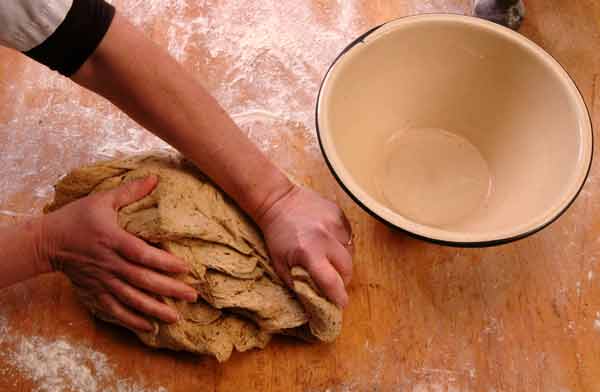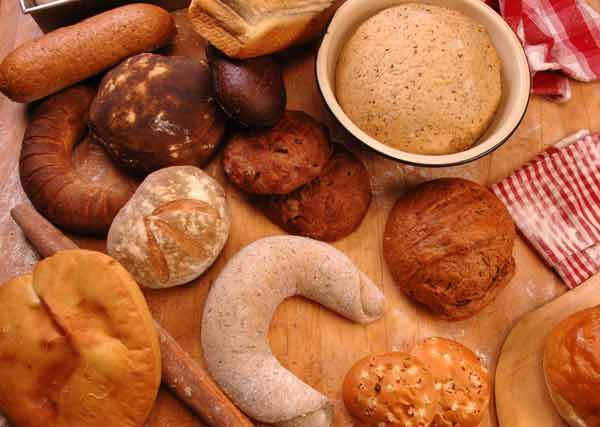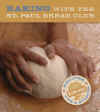Baking with the St. Paul Bread Club
by Kim Ode
![]()
An excerpt
It wasn't until a few years ago, after I had started baking bread for my family with a convert's intensity, that I began to appreciate the sacrifice my mother had made each time she shook loose a loaf of bread from a hot pan.
Her fresh bread never took me by surprise. All morning the big yellow Pyrex bowl would sit on the counter, the drape of the dish towel subtly shifting as the dough swelled past the rim. By afternoon the bread was in pans, the kitchen filling with the metallic whiff of a preheating oven.
The beauty of this incremental process was how it let me arrange my day. I could bike the road leading to and from our farm, then swing for an hour on the bag of straw hanging on a rope from the hayloft's rafters, and then pet the new kittens -- there were always new kittens -- and time each diversion so that I could walk into the kitchen just when Mom was tapping the loaves to hear if they sounded hollow. Even when they were still too hot to handle, still too tender to cut, she would slice the end off of one and pass it to me.
There is nothing like a slice of hot, fresh bread, the steam still rising through a sheen of butter. Especially the heel of a loaf, she'd say, and with a child's breathtaking selfishness, I would agree and eat the whole thing.
Today, in my own kitchen, I also let that first hot slice go to the child -- or the husband -- who just happens to be thirsty or checking the thermostat or riffling through the junk drawer looking for a whatchamajig as I'm easing a loaf from the oven. I could claim that slice for my own. But I hand it over, even while imagining the faint resistance of the crust and give of the crumb between my own teeth. And it's OK, because I know that others have arranged their day around bread. That may even be the whole point.

We talk a lot about the desire for community these days. We wonder at how the Internet enables people to connect over a mind-boggling array of passions. We live in amazing times. But I'm throwing in my lot with those who marvel over the connection we can make over a loaf of home-baked bread.
Several years ago, Dan "Klecko" McGleno founded the St. Paul Bread Club, a loose affiliation of home bakers from around the Twin Cities. Four times a year, Klecko opens the doors of the St. Agnes Baking Company, just north of downtown St. Paul and not far from where the city's first grist mill was built on Phalen Creek in 1842. He's production manager there and saw the club as a way to give bakers of varying experience the chance to talk bread, trade tips, hear what a master baker advises, bake their own dough, and eat each others' bread.
It's a community that almost slipped from our grasp.
Well, that may be a bit of an exaggeration, the sort of modern navel-gazing that lets us imagine our homely lives as pivot points in time. The fact is that people have been baking bread for ten thousand years without pause. We've always gathered over bread. In 1849, when the city of St. Paul issued its first business directory, there were five bakers -- more than the tally of doctors, shoemakers, gunsmiths, wheelwrights, blacksmiths, or harness makers.
But over time we've baked less. As with beating our clothes on river rocks or plucking the feathers from our chickens, the ability to pay someone else to do our household chores was a sign of our progress. Likewise, the ability to lay a platter of bread as white as Elmer's Glue on our dinner table showed our success: We could afford to buy bread made with flour carefully and expensively sifted free of its whole grain origins.
It's funny now to think of something as modest as Wonder Bread as a symbol of domestic progress. But it's sobering to realize how gradual changes in bread can define a generation. Several of the home bakers in this book recalled how their kids groaned at the prospect of school lunch sandwiches made with Mom's cracked wheat bread. None of the other kids' lunches looked like something that came from a log cabin -- maybe even a cave. Or so it felt.
At our house there's still always a loaf of airy, store-bought English muffin bread for my son's peanut butter and jelly sandwiches -- and even that's a little on the sturdy side for grilled cheese sandwiches, as far as my daughter is concerned. They like my crackly baguettes, pizza-friendly focaccias, or chewy ciabattas. But anything sourdough is the object of painstaking courtesy; they don't want to hurt my feelings, but well, it's not really their favorite.
So I choose my battles and give thanks that our household never entertained the low-carb revolution, a stance I regard as a victory of common sense and moderation. More and more, people are coming back to bread, finding the truth in the old punch line about the downside of a longer life: It just means more years of denial. Barely three years ago, close to 10 percent of U.S. adults were on the Atkins Diet; in 2005 the Atkins Nutritional Company filed for bankruptcy after that proportion fell to 2 percent.
At the same time the act of baking bread has changed more in the past twenty-five years than it has in the past five hundred. The invention of the bread machine alone has inspired legions of people to delve into the world of yeast, not to mention solving the "office gift" dilemma for many weddings.
Cookbook sales are growing and the number of books devoted solely to bread continues to climb. So we have rediscovered bread. Now we need to rediscover our skills and, through them, a community of home bakers. It sounds like a pretty straightforward goal, yet it's not as simple as I once thought.
A story: Back in 2001 I was thumbing through the course catalog for the North House Folk School in Grand Marais, Minnesota. The school teaches traditional northern crafts and champions the philosophy of the Scandinavian folkehøjskole, where learning is valued for its own sake.
I was a columnist for the Star Tribune and mired in one of my occasional funks about the transience of daily newspapering. So when I saw a class on how to build a wood-fired brick bread oven, I knew that's what I had to do. Here was something that would last the ages. And I was determined to do it all by myself.
I had no idea what I was getting into, only sure that my labors would have a tangible result, from which tangible rewards would follow. I'd always loved bread and had always meant to get more serious about making it. So I signed up and, with a dozen others, learned from master oven-builder Alan Scott the mysteries of mortar, load-bearing archways, airflow, and precise measurements.
I returned home to find that what I really needed was my dozen classmates, but I stubbornly kept everyone at bay. The project took months, from finding the materials to hauling them to our backyard -- about three thousand pounds of stuff, all told -- to transforming them into an oven. I had to stop work for the winter when temperatures dropped too low for the mortar to cure. I finally accepted my husband's offer of help, and he built the framing over which he then flung stucco. (This also is why he gets those first slices of hot bread.) Friends were skeptical of my venture, to say the least. But I assured them that I had a goal much larger than simply building an outdoor oven.
One evening, I was regaling a friend about this grander plan, telling her how I wanted to re-create the culture of a French village where neighbors would bring their risen dough to the communal oven. As our breads emerged, our bonds would strengthen. Gathered at the hearth, friends and neighbors would build connections that would cross the boundaries of gender, age, politics, and class. Finally, I noticed the half-quizzical, half-pitying look on her face.
"But Ode," she said, "you're the only one I know who bakes bread!"
Hmmm. I had to admit that she was right. The community of home bakers is not exactly invading the ranks of American life like aproned soldiers pouring from some Trojan horse. Yet after decades of baking less, we are beginning to bake more. It's a start. I credit the renaissance of artisanal breads for reawakening us to the satisfaction available in a bite of sourdough flecked with wild rice or a rye bread born of a long rise. Far from discouraging us from trying our hand, I think the growing number of terrific bakeries are inspiring people to give baking a try.
Over and over, the bakers in this book volunteered how making bread is a sort of therapy. For those who favor sourdough, there is the ritual of feeding the starter, a regular nurturing of something that is as alive as any other member of their family. Don't smirk. In fact, bakers often name their sourdough starters in a nod to what's become one of the more reliable relationships in their lives. Even bakers who've long resisted names as a corny conceit end up relenting. And so my bubbly starter eventually was christened "Glinda," after the good witch in The Wizard of Oz.
Kneading, however, is where most of the therapy lies. If there were a study assessing the mental health of people who, on a regular basis, kneaded a shaggy boulder of dough into a bouncy, satiny orb, I'm convinced that they would set a new high standard for even-keeledness.
A session of kneading compels us to be alone with our thoughts, a condition that seems increasingly endangered, as a glance down any store aisle or at the next lane of traffic will tell you. Simply put, you cannot knead bread while talking on a cell phone.
Kneading is a full-body experience, a leaning in and pushing through all the way from your firmly planted feet to your shifting shoulders. A really stiff dough should leave you a little winded. As it grows smoother and bouncier, the dough absorbs frustrations about a job, worries about a parent, anxieties about a teen, and even last night's argument. Why bore your friends?
This is where you come
in.
This book is for the growing community of bakers, from the experienced to the novice. In it members of the St. Paul Bread Club have shared not so much how they bake but why they bake. After all, the how is not really such a secret, having been shared since Egypt's earliest history. But the why can be a revelation, whether it's a means of monitoring healthy ingredients, of honoring an ethnic culture, or of seeking some respite in a busy life. Best of all, these bakers believe in the power of a shared recipe.
These days, baking no longer is a chore but a choice. The home bakers profiled here would like to help. Their intent is little different from the purpose noted in a 1916 pamphlet distributed by the Ramsey County Flour Company, makers of Miss Saint Paul Flour. In it baking expert P. O. Walker opened on this confident note: "In placing this booklet in your hands we feel that we are positively benefiting you, your family and your community."
Cooking, he added, relies on two essential skills: knowing how and using good judgment. "These two things go far towards making house work either a task or a pleasure. To some it is drudgery, to others it is an accomplishment," he wrote. "And here let me say, many people would rather eat your good rolls or bread than they would hear your good music."
I'm pretty sure he meant that to sound inspiring. So let's bake.

Now available
Published by the Minnesota Historical Society Press
Book About Kim Recipes Tips Classes Klecko Stirsby Bread Links